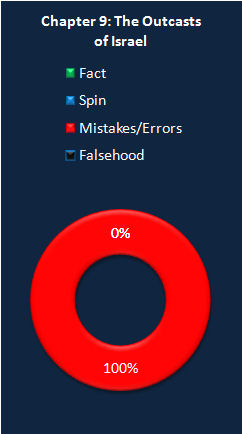
FAIR is a non-profit organization dedicated to providing well-documented answers to criticisms of the doctrine, practice, and history of The Church of Jesus Christ of Latter-day Saints.
< Criticism of Mormonism | Books | Losing a Lost Tribe: Native Americans, DNA, and the Mormon Church
FAIR Answers—back to home page
| Chapter 6 | A FAIR Analysis of: Losing a Lost Tribe: Native Americans, DNA, and the Mormon Church, a work by author: Simon G. Southerton
|
Chapter 10 |
| Claim Evaluation |
| Losing a Lost Tribe |

|
We should expect the common culture, history and ancestry to be revealed in the genes of the lost 10 tribes and those of the kingdom of Judah if they are actually related.Author's sources:
- No source given.
"Book of Mormon and DNA Studies," Gospel Topics on LDS.org:
Much as critics and defenders of the Book of Mormon would like to use DNA studies to support their views, the evidence is simply inconclusive. Nothing is known about the DNA of Book of Mormon peoples. Even if such information were known, processes such as population bottleneck and genetic drift make it unlikely that their DNA could be detected today. As Elder Dallin H. Oaks of the Quorum of the Twelve Apostles observed, “It is our position that secular evidence can neither prove nor disprove the authenticity of the Book of Mormon.”[1]
Identifying DNA criteria for Manasseh and Ephraim may always be beyond our reach. But, even identifying markers for Jews—a group that has remained relatively cohesive and refrained from intermarriage with others more than most groups—is an extraordinarily difficult undertaking.
One author cautioned:
Studies of human genetic diversity have barely begun. Yet the fashion for genetic ancestry testing is booming. . . . Other groups, such as Jews, are now being targeted. This despite the fact that Jewish communities have little in common on their mitochondrial side—the maternal line down which Judaism is traditionally inherited. It's the male side that shows common ancestry between different Jewish communities—so, of course, that's what the geneticists focus on. . . . Geneticists—like preachers and philosophers before them—need to avoid promising more than they can deliver. [2]
The Lemba can be genetically tied to the line of Aaron.Author's sources:
- Webber Ndoro, "Great Zimbabwe," Scientific American, Nov. 1997, 62-67.
- Tudor Parfitt, Journey to the Vanished City: The Search for a Lost Tribe of Israel, 1997.
- Thomas, et al., "Y Chromosomes Traveling South: The Cohen Modal Haplotype and the Origins of the Lemba 'Black Jews of Southern Africa'," American Journal of Human Genetics 66:674-86 (2000).
- Ezra 2꞉35
Thomas Murphy uses the "Lemba" as an example of a group proven to be Jewish via DNA testing. But, this example is misleading. The Lemba were identified as Jewish because of a marker called the "Cohen modal haplotype." This marker is carried by about half of those who claim descent from Aaron, Moses' brother, and only 2-3% of other Jews.
But, the Book of Mormon does not suggest—and in fact seems to exclude—the idea that Levites (the priestly family of Aaron) were among the Lehi party. Without priestly families, one would not expect to find the Cohen modal haplotype! Yet, only 2-3% of modern Jews from non-priestly families (to say nothing of Ephraim and Manasseh—remember, Lehi and company are not "Jews") can be identified by this test. [3] Are these 97-98% of modern Jews then not Jews because the genetic test is negative for them? Excluding the Nephites on the basis of such a poor test that we would not even expect them to pass (since they do not include Levitical families) shows how far the critics will twist the evidence to find fault.
In Mesoamerica, there is no genetic support for European lineages.Author's sources:
- No source given.
"Book of Mormon and DNA Studies," Gospel Topics on LDS.org:
Population bottleneck is the loss of genetic variation that occurs when a natural disaster, epidemic disease, massive war, or other calamity results in the death of a substantial part of a population. These events may severely reduce or totally eliminate certain genetic profiles. In such cases, a population may regain genetic diversity over time through mutation, but much of the diversity that previously existed is irretrievably lost.
In addition to the catastrophic war at the end of the Book of Mormon, the European conquest of the Americas in the 15th and 16th centuries touched off just such a cataclysmic chain of events. As a result of war and the spread of disease, many Native American groups experienced devastating population losses.22 One molecular anthropologist observed that the conquest “squeezed the entire Amerindian population through a genetic bottleneck.” He concluded, “This population reduction has forever altered the genetics of the surviving groups, thus complicating any attempts at reconstructing the pre-Columbian genetic structure of most New World groups.”[4]
Approximately ninety percent of the Amerindian population died out following contact with the Europeans; most of this was due to infectious disease against which they had no defense. [5]
Since different genes likely provide different resistances to infectious disease, it may be that eliminating 90% of the pre-contact gene pool has significantly distorted the true genetic picture of Lehi's descendants. Studies of pre-Columbian human remains have not shown any extinct haplotypes—as one would expect given the small contribution made by a Lehite colony. Gene frequency, however, could well have been altered by such a dramatic die-off, suggesting that caution should be used in assuming that modern Amerindian populations are an identical match for pre-Columbian gene frequencies.
Notes

FAIR is a non-profit organization dedicated to providing well-documented answers to criticisms of the doctrine, practice, and history of The Church of Jesus Christ of Latter-day Saints.
We are a volunteer organization. We invite you to give back.
Donate Now